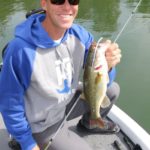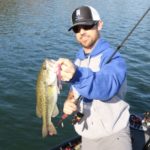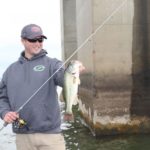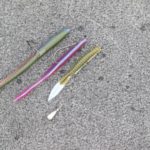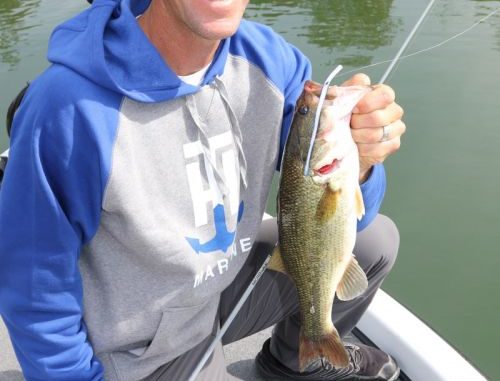
Dropshotting might seem simple, but understanding how to make small adjustments to match specific situations can put more bass in the boat. Here are the pros’ tips.
It’s the go-to rig for finessing finicky fish, nudging the cold-weary and lightly probing a variety of hard-cover scenarios from docks to laydowns, to bridges.
No doubt about it: The dropshot gets it done when other baits struggle.
But, while the general rig may be broad-reaching, several design points merit consideration.
Like any tool or tactic, dialing in the details that are most relevant to your objective bears significant impact on the final results.
Consider these areas of dropshot variation:
Bait styles
Worms from 4 to 6 inches long comprise the majority of dropshot selections.
Options are many, but Bassmaster Elite Series pro Aaron Martens keeps it simple by basing his selection on water temperature because it relates to feeding aggression levels.
“If the water is in the mid-60s or lower, I go with a 6-inch Roboworm Straight Tail Worm,” Martens said. “But if the water’s in the upper-60s, or 70s, then I like the Roboworm Fat Worm.”
A common worm alternative is a baitfish profile like Strike King’s KVD Dream Shot, Half Shell, Yamamoto Shad Shape Worm and YUM Warning Shot. Typically designed with tails that kick and wiggle, these baits are designed to mimic a meandering forage fish.
For a bolder look — especially around hydrilla edges, reeds, etc. — try a craw-style bait. This beefy profile is particularly effective during winter and spring when crustaceans make up a significant portion of the bass diet.
If a more subtle version of the crustacean look is in order, craw worms like the Gambler Flap Daddy or Missile Baits Fuse blend slender bodies with crawfish claws.
The Flap Daddy sports full-sized pinchers, while the more-finesse Fuse includes slender appendages offering just enough action to garner attention.
Weights
Starting with materials, lead sinkers cost less than those made of tungsten, but the latter offer distinct advantages.
For starters, tungsten’s density means you can decrease your weight profile. Also, because that density creates a sharp impact with whatever the weight hits, you’re getting constant bottom “reads.”
As far as shapes, elongated cylinders and tear drops are the common selections. Martens likes a cylinder weight when he’s fishing a dropshot across any type of entangling bottom like brush, wood, etc., because the slender profile tends to slip in and out of tight spots better.
A tear-drop weight isn’t necessarily snag-prone, but it is particularly effective when Martens needs to interpret the bottom to detect key changes. The round bottom presents greater surface area, which combines with tungsten’s sensitive composition to deliver emails to your fingertips.
“The rounded edge of a tear drop weight rolls well, and it transfers signals well from the bottom,” Martens said. “That tells you if you’re coming through mud or rock or over wood.”
Martens also will use a cylinder weight when vertically fishing a dropshot in deeper water, as the streamlined form suffers less water drag and therefore reaches bottom more quickly.
Most prefer the lightest weight possible, but consider that water pressure increases with depth. That means you can often get away with less weight than you might think in deeper spots.
Heavier weights help most for punching through rough water and current to ensure your bait reaches the target area.
Also, faster-falling baits can trigger suspended fish to bite rather than lose a potential meal.
Line & leaders
Martens’ rule of thumb for standard leader measurement is simple: Match your worm length.
He will, however, alter that for situational needs. Earlier in the year, for instance, bass tend to feed closer to the bottom, particularly when post-cold front conditions have them holding lower.
In such scenarios, by decreasing his dropshot leader to half or one third of his worm’s length — sometimes, as short as an inch — he not only puts his bait where the fish are looking but he creates an enticing presentation that leverages the dynamics of bottom proximity.
“A short leader gives your bait a quicker bounce,” Martens said. “It’s like dribbling a basketball: If you dribble it standing up, the ball moves slowly, but if you get closer to the ground, it tightens up.
“It’s the same with a dropshot. You get a quicker action in the worm.”
Noting that he considers anything 3 inches or less “short,” Martens said low-lying bass generally respond better to a sharp, snappy action held right in their faces, as opposed to the subtle, waving action from a leader of 20 inches or more.
Martens is certainly not averse to longer leaders; in fact, he’ll extend his leaders anytime fish are suspending in the water column — perhaps over a brush pile or stake bed that’s likely to ensnare baits dropped into the thicket.
In any case, Martens noted the snappy action characteristic of a short leader is less important in that situation because bass are more likely to be looking up and feeding more actively.
Tip: Try a long-leadered dropshot around drain pipes with light current. Minnows often hold in a manageable outflow to feed on tiny stuff that tumbles out with draining water. Holding a small dropshot bait along the current edge creates the illusion or a minnow that’s not watching his six.
Swivels
Line twist is the bane of dropshotting. A bait standing perpendicular to your line creates water drag, which creates the spinning motion that can twist line and lead to those dreaded wind knots that often plague spinning gear.
FLW Tour pro Cody Meyer cures this ill by linking his main line and leader with a small swivel (see “The right outfit” sidebar for more).
Whether he’s pitching his dropshot into 6 feet of water by a dock or dropping it into 15 feet of water by a deeper bridge piling, Meyer knows bait rotation won’t impact his main line.
Simplifying the dropshot rigging, Gamakatsu offers the Swivel Shot, essentially a swivel connected to a line clip with a hook mounted on a wire stem between the two parts. Just tie your main line to the swivel and add a leader to the clip.
With the hook free to rotate on the stem, bait movement won’t affect your line.
Similarly, the VMC Spin Shot mounts a hook on a wire stem between two ends of a swivel.
Best rigging
Most of the major hook brands offer light-wire task-specific hooks that you can size to the bait of your choice. As far as specific models, base that on a handful of common rigging options:
• Nose hooking — “This is what I’m going to throw in open water,” Meyer said of this straightforward hook placement. “For one thing, there’s more action. There’s less constriction on the bait, so it moves more freely.”
• Wacky rigged — Inserting a hook through the bait’s middle so it sits perpendicular to the hook with the ends wiggling freely, this dropshot option is a good bet for pressured fish that need a little more convincing.
“Let’s say I fish a spot and I’m catching a few by nose-hooking them, but the bite stops: That’s when the wacky rig is going to come into play,” Meyer said. “You also want to throw this in open water, but it is superior around cruising fish and bed fish.”
• Texas rigged — A small worm hook allows Meyer to create that classic weedless arrangement that keeps snaggy cover at bay. Anywhere Meyer’s concerned about snagging, the Texas-rigged dropshot bait gets the call.
“The hook-up ratio is a little better on a Texas rig, but I don’t throw it in open water because the bigger hook will constrict the worm and limit the action,” Meyer said.
Fully analyzed, the dropshot technique is actually more detailed than it might appear.
But don’t be intimidated by the complexities: Time on the water will guide you to the right formulas for the scenarios you fish. Dial in your preferences and keep a couple of different dropshot rigs handy — this is a bona fide fish catcher.
